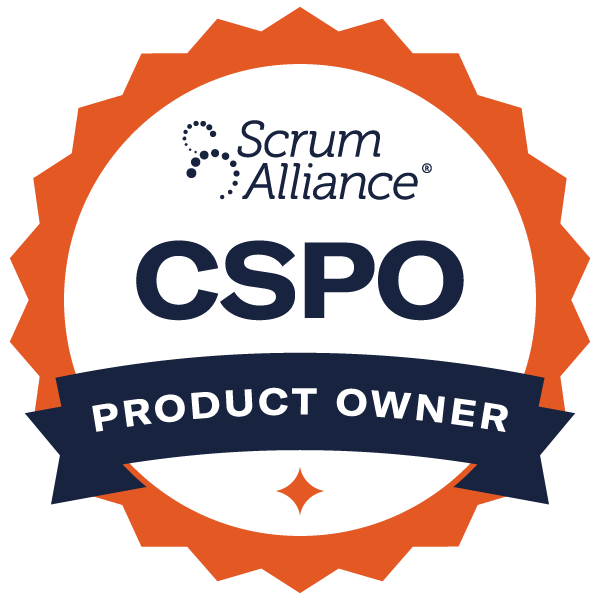Understanding the Role of the Product Owner
Fundamentals of the Product Owner Role
1.1. Responsibilities and Benefits
1.2. Value Realization
-
Role of Product Owner:
-
Delivering product solutions that delight customers and users within the constraints of technical feasibility.
-
Continuous engagement with stakeholders to ensure alignment with user needs and organizational goals.
1.3. Product Owner’s Role in Scrum Events
-
Sprint Planning: Defines the sprint goal and prioritizes backlog items.
-
Daily Scrum: May attend to understand progress but does not direct.
-
Sprint Review: Presents the increment and gathers feedback.
-
Sprint Retrospective: May participate to improve processes.
1.4. Personal Qualities of a Product Owner
-
Emotional intelligence
-
Collaborative skills
-
Decision-making ability
-
Empathy with customers
-
Conflict management
-
Communication skills
-
Business acumen
-
Domain expertise
1.5. Anti-Patterns
-
Order Taker: Reduces strategic value.
-
"It’s all important": Lack of focus and prioritization.
-
Abdication of Details: Leaves the team without detailed guidance.
-
Impact on Scrum Team and Organization:
1.6. Organizational Contexts
-
Complete Ownership: Full oversight of customer, problem, and solution.
-
Delivery of Others’ Ideas: Executing someone else’s vision.
-
Shared Services: Managing a service used by multiple teams.
-
Impact on Approach:
1.7. Why Scrum Works for Product Development
-
Real-World Product Example: Successful outcomes through feedback loops.
-
Risk Reduction: Inspection and adaptation over short timeframes.
-
Accepting Imperfect Knowledge: Enables error corrections.
Working with Stakeholders
1.8. Transparency Techniques
-
Release Burn-Up Chart: Visual representation of progress.
-
Roadmap: High-level plan outlining future product features.
-
Sprint Reviews: Regular meetings to showcase the increment.
1.9. Decision-Making Approaches
-
Product Owner Decides: Makes a decision and informs the team.
-
Consultative: Consults with the team or stakeholders before deciding.
-
Delegative: Delegates decision-making to the team when appropriate.
1.10. Facilitator Role
1.11. Stakeholder Engagement Technique
Working with the Development Team
1.12. Collaboration Activities
-
Defining Done: Establishing clear criteria for completion.
-
Backlog Creation: Identifying and documenting backlog items.
-
Refinement and Ordering: Prioritizing and refining items for clarity and feasibility.
Product Ownership with Multiple Teams
1.13. Managing Dependencies
-
Techniques:
-
Coordinate with other Product Owners.
-
Redefine backlog items to remove dependencies.
-
Ensure product backlogs are visibly shared.
Describing Purpose and Strategy
Product Strategy
2.1. Defining Key Terms
-
Purpose: The fundamental reason for the product’s existence.
-
Vision: The long-term goal the product aims to achieve.
-
Mission: The path the product takes to achieve the vision.
-
Strategy: The approach to fulfilling the mission.
-
Tactics: Specific actions taken to execute the strategy.
2.2. Communicating Purpose
-
Describe the Problem: What problem is being solved?
-
Who is Affected: Identify the target audience.
-
Improvement Efforts: How will the team improve the situation?
-
Evaluating Effectiveness: Metrics and feedback mechanisms.
2.3. Identifying Purpose or Strategy
2.4. External Impacts on Strategy
-
Alignment with Business: Ensuring the product strategy aligns with business objectives.
-
Hiring: Recruiting the right talent.
-
Channel Partners: Collaborating for product distribution.
-
Cost Structure: Managing financial constraints.
Roadmaps and Release Planning
2.5. Delivery Strategies
-
Opportunistic: Adapting to market changes quickly.
-
Multi-Sprint Releases: Planning releases across several sprints.
-
Fixed Date/Scope: Committing to a specific release date or feature set.
-
Release Each Sprint: Delivering usable increments at the end of each sprint.
-
Continuous Delivery: Releasing features as they are ready.
2.6. Creating a Roadmap
2.7. Progressive Delivery
Understanding Customers and Users
Customer Research and Product Discovery
3.1. Needs of Key Groups
-
Users: Directly interact with the product.
-
Customers: Purchase the product.
-
Stakeholders: Benefit indirectly from the product’s success.
3.2. Customer Segmentation
-
Approaches:
-
Customer types.
-
Geography.
-
Regulatory bodies.
3.3. Product Prioritization Strategy
3.4. Connecting Teams to Customers
-
Benefits:
-
Deeper understanding.
-
Increased empathy.
-
Techniques:
-
Job shadowing.
-
Customer interviews.
-
Usability testing.
3.5. Describing Users and Customers
3.6. Generating Ideas
3.7. Aspects of Product Discovery
-
User Research: Understanding user needs and behaviors.
-
Experience Design: Crafting intuitive user interactions.
-
Usability Engineering: Ensuring the product is user-friendly.
3.8. Building Empathy
-
Techniques:
-
Job shadowing.
-
Customer interviews.
-
Customer observation.
Testing Product Assumptions
4.1. Sprint Review
4.2. Assumptions vs. Hypotheses
4.3. Scrum and Testing Assumptions
4.4. Opportunities for Testing
-
Stages:
-
Product discovery.
-
Product development.
-
Delivery.
4.5. Reasons for Discovery and Validation
-
Low Use Rate: Addressing underused features.
-
Startup Failure Rate: Mitigating risks.
-
Cognitive Bias: Reducing decision-making errors.
-
Risk Reduction: Minimizing uncertainties.
4.6. Prioritizing Assumptions
4.7. Testing Approaches
Working with the Product Backlog
Differentiating Outcome and Output
5.1. Outcome vs. Output
5.2. Attributes of Product Backlog Items
Defining Value
5.3. Defining Value
-
Assumed Value: Hypothetical benefits.
-
Actual Value: Realized benefits.
-
ROI: Return on investment.
5.4. Measuring Value
5.5. Stakeholder Perspectives
Ordering Items
5.6. Criteria for Ordering
-
Strategic Alignment: Fit with business goals.
-
Business Value: Impact on revenue or market position.
-
User Value: Importance to end-users.
-
Risk: Potential uncertainties.
5.7. Techniques for Ordering
-
Kano Attributes: Classifying features based on user satisfaction.
-
Validated Learning: Prioritizing based on learning outcomes.
-
Walking Skeleton: Developing a minimal yet complete version of the product.
-
Dot Voting: Team-based prioritization.
Creating and Refining Items
5.8. Sources of Product Backlog Items
-
Stakeholder Groups: Inputs from various stakeholders.
-
Regulatory Requirements: Compliance needs.
-
Defects: Issues found in the product.
-
Technical Concerns: Technical debt and improvements.
5.9. Reflecting Impact and Outcome
5.10. Product Backlog Refinement
5.11. Just-in-Time vs. All-at-Once Refinement
5.12. Communication Tools
-
Tools:
-
Roadmaps.
-
User story maps.
-
Wireframes.
-
Flowcharts.
5.13. Identifying Small, Valuable Subsets
5.14. Benefits of Decomposition
5.15. Refining Larger Items




 Certified Scrum Product Owner®
Certified Scrum Product Owner®
 Certified Scrum Product Owner®
Certified Scrum Product Owner®




